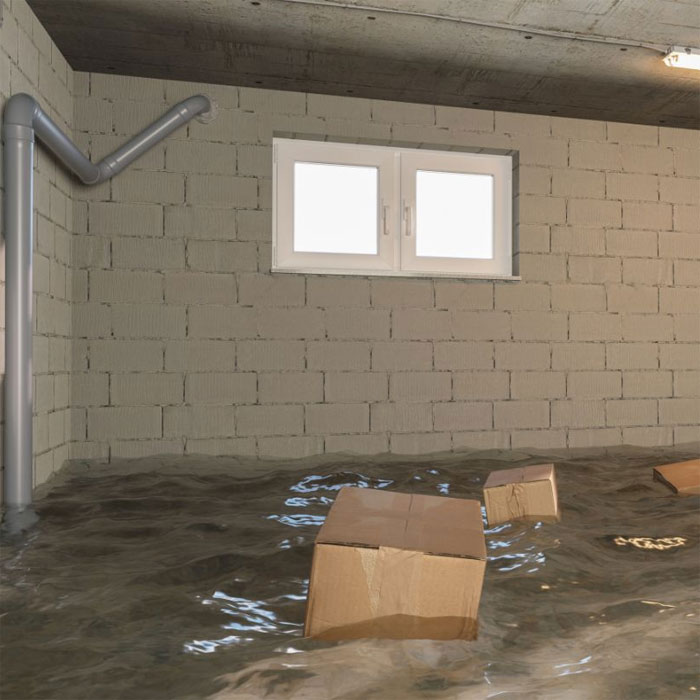
A home should be a sanctuary of comfort and security, but the threat of floods and leaks can undermine this sense of safety. Whether from heavy rainfall, plumbing failures, or other unforeseen circumstances, floods and leaks pose significant risks to property and well-being. However, with proactive measures and effective strategies, homeowners can mitigate these risks and safeguard their homes against water damage.
In this blog, we explore various methods for addressing and controlling floods and leaks, ranging from sump pumps and leak alarms to simple DIY solutions like sealing door bottoms and keeping a Shop-Vac handy.
Sources of Floods and Leaks in a Home
Before delving into mitigation strategies, it's essential to understand some of the potential sources of floods and leaks in a home:
Heavy rainfall, storms, or nearby bodies of water can lead to external flooding, causing water to infiltrate basements, crawl spaces, and ground-level areas of the home.
Inadequate drainage around the home, such as clogged gutters, improper grading, or insufficient slope away from the foundation, can contribute to water pooling near the home. Over time, this water may infiltrate the basement or crawl space, causing flooding or leaks.
Plumbing Leaks
Broken pipes or worn-out plumbing fixtures can result in leaks that range from minor drips to major water damage. And pipes located in unheated or uninsulated areas of the home, such as crawl spaces, attics, or exterior walls, are susceptible to freezing during cold weather. Frozen pipes can burst, causing significant water damage when they thaw.
Gaps in doors and windows, cracks in foundations, or compromised seals can allow water to seep into the home, particularly during heavy rain or flooding events.
Malfunctioning appliances such as water heaters, washing machines, and dishwashers can cause leaks if not properly maintained or if their components deteriorate over time.
Sewer or Septic Backups
Sewer or septic backups occur when wastewater from the sewer or septic system flows back into the home's plumbing system. This can happen due to blockages in the line, tree root intrusion, or heavy rainfall overwhelming the system. Sewer and septic backups can lead to significant water damage and pose health risks due to contamination.
Damaged or deteriorated roofing materials, or deteriorated seals around chimneys or vents, can allow water to penetrate the roof and leak into the attic or interior spaces of the home. Improperly sealed windows or doors can allow water to enter the home during rainstorms or high winds.
Addressing Floods and Leaks Before They Begin
Sump Pumps
Sump pumps are essential tools for managing groundwater and preventing basement flooding. These devices are installed in a sump pit or basin located below the basement floor, where they automatically activate to pump out excess water when the water level rises above a certain threshold.
To ensure the effectiveness of a sump pump:
- Regularly inspect and test the pump to ensure it is in working condition.
- Install a backup power source, such as a battery backup or generator, to keep the pump running during power outages.
- Consider installing a sump pump alarm to alert you to pump failures or high water levels.
Plumbing Maintenance
Regular inspection and maintenance of plumbing systems can help prevent leaks and water damage. Here are some key maintenance tasks:
- Check for signs of leaks, such as water stains, dampness, or mold growth, under sinks, around toilets, and behind appliances.
- Inspect pipes, fittings, and connections for corrosion, rust, or signs of wear and tear.
- Replace worn-out washers, seals, and gaskets promptly to prevent leaks.
- Consider installing water leak detection devices or smart water sensors that can alert you to leaks and abnormalities in your plumbing system.
Sealing gaps, cracks, and openings in doors, windows, and foundations can help prevent water infiltration during heavy rain or flooding. Here are some sealing techniques:
- Use weatherstripping or door sweeps to seal gaps around exterior doors, especially at the bottom.
- Apply caulking or sealant around windows, door frames, and other entry points to create a watertight seal.
- Seal cracks in concrete or masonry foundations using hydraulic cement or epoxy sealants.
Leak Alarms and Detection Systems
Installing leak alarms or water detection systems can provide early warning of potential leaks or water damage, allowing homeowners to take prompt action. These systems typically consist of sensors placed in areas prone to leaks, such as near water heaters, washing machines, or under sinks, which trigger an alarm or notification when they detect moisture or water.
Having a shop-vacuum or wet/dry vacuum on hand can be invaluable for quickly removing standing water from floors, carpets, and other surfaces in the event of a flood or leak. When using a Shop-Vac:
- Ensure the vacuum is rated for wet/dry use and equipped with appropriate attachments for water extraction.
- Use caution when vacuuming water to avoid electrical hazards, and always follow manufacturer instructions and safety guidelines.
- Consider renting or purchasing a portable submersible pump for larger-scale water extraction tasks.
Storing valuables, electronics, and important documents in elevated or waterproof containers can help protect them from water damage during floods or leaks. Additionally, using flood-resistant building materials and finishes in vulnerable areas of the home, such as basements or crawl spaces, can mitigate damage and facilitate easier cleanup and restoration.
What To Do After a Flood in the Home
Safety should always be the top priority. If flooding is severe or poses a risk to your safety, evacuate the premises immediately and seek higher ground. Do not attempt to enter flooded areas until it is safe to do so.
Turn off electricity, gas, and water mains to prevent further damage and reduce the risk of electrical hazards or gas leaks. If you're unsure how to do this safely, contact utility providers for guidance or wait for professional assistance.
Once it's safe to do so, assess the extent of the flooding and the damage it has caused. Document the damage through photographs or videos for insurance purposes. Take note of affected areas and items for later assessment and restoration.
Use a pump, wet/dry vacuum, or buckets to remove standing water from affected areas as quickly as possible. The longer water sits, the greater the damage it can cause, including structural damage, mold growth, and damage to belongings.
Open windows and doors to ventilate the space and promote airflow. Use fans, dehumidifiers, and moisture-absorbing materials to aid in drying out wet surfaces and materials. Carpeting, furniture, and other porous items may need to be removed and dried separately.
Floodwater can contain contaminants and pathogens, posing health risks. Thoroughly clean and disinfect all surfaces, including walls, floors, and furniture, using appropriate disinfectants or cleaning solutions. Wear protective gear such as gloves and masks during the cleaning process.
Once the area is dry, inspect for any structural damage, including cracks in walls, foundation damage, or compromised electrical systems. Address any issues promptly to prevent further damage or safety hazards.
Dispose of any items that cannot be salvaged or safely cleaned, such as heavily damaged furniture, carpeting, or electronics. Follow local guidelines for proper disposal of flood-damaged materials.
Depending on the extent of the damage, you may need to enlist the help of professionals, such as water damage restoration specialists, electricians, and plumbers. They can assess the damage, make necessary repairs, and provide guidance on mitigation measures to prevent future flooding.
Floods and leaks pose significant risks to homes and property, but with proactive measures and effective strategies, homeowners can reduce their vulnerability to water damage. From installing sump pumps and leak alarms to sealing door bottoms and keeping a shop-vacuum nearby, there are numerous steps individuals can take to address and control floods and leaks in their homes. By prioritizing maintenance, investing in protective measures, and remaining vigilant for signs of water damage, homeowners can create a safer and more resilient living environment for themselves and their families.


